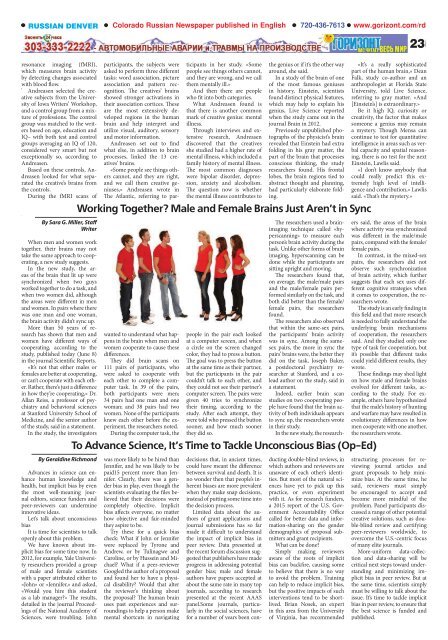Горизонт N23/852
Горизонт (газета) — (Gorizont англ. Horizon ) первая и наиболее влиятельная газета, издающаяся на русском языке в штатеКолорадо, США. Еженедельник, выходит по пятницам, формат Таблоид, 128 цветных и чернобелых страниц, распространяется в городах, составляющих метрополию Денвера (Большой Денвер), и в других населенных пунктах штата Колорадо от графства Саммит до графства Эль—Пасо. Полная электронная версия газеты «Горизонт» доступна в сети Интернет. Подробнее http://en.wikipedia.org/wiki/Gorizont_(newspaper)
Горизонт (газета) — (Gorizont англ. Horizon ) первая и наиболее влиятельная газета, издающаяся на русском языке в штатеКолорадо, США. Еженедельник, выходит по пятницам, формат Таблоид, 128 цветных и чернобелых страниц, распространяется в городах, составляющих метрополию Денвера (Большой Денвер), и в других населенных пунктах штата Колорадо от графства Саммит до графства Эль—Пасо. Полная электронная версия газеты «Горизонт» доступна в сети Интернет. Подробнее http://en.wikipedia.org/wiki/Gorizont_(newspaper)
Create successful ePaper yourself
Turn your PDF publications into a flip-book with our unique Google optimized e-Paper software.
RUSSIAN DENVER<br />
Colorado Russian Newspaper published in English 720-436-7613 www.gorizont.com/rd<br />
23<br />
resonance imaging (fMRI),<br />
which measures brain activity<br />
by detecting changes associated<br />
with blood flow.<br />
f Andreasen selected the creative<br />
subjects from the University<br />
of Iowa Writers’ Workshop,<br />
and a control group from a mixture<br />
of professions. The control<br />
group was matched to the writers<br />
based on age, education and<br />
IQ– with both test and control<br />
groups averaging an IQ of 120,<br />
considered very smart but not<br />
exceptionally so, according to<br />
Andreasen.<br />
Based on these controls, Andreasen<br />
looked for what separated<br />
the creative’s brains from<br />
the controls.<br />
During the fMRI scans of<br />
y<br />
By Sara G. Miller, Staff<br />
Writer<br />
When men and women work<br />
together, their brains may not<br />
take the same approach to cooperating,<br />
a new study suggests.<br />
In the new study, the areas<br />
of the brain that lit up were<br />
synchronized when two guys<br />
worked together to do a task, and<br />
when two women did, although<br />
the areas were different in men<br />
and women. In pairs where there<br />
was one man and one woman,<br />
the brain activity didn’t sync up.<br />
More than 50 years of research<br />
has shown that men and<br />
women have different ways of<br />
cooperating, according to the<br />
study, published today (June 8)<br />
in the journal Scientific Reports.<br />
«It’s not that either males or<br />
females are better at cooperating,<br />
or can’t cooperate with each other.<br />
Rather, there’s just a difference<br />
in how they’re cooperating,» Dr.<br />
Allan Reiss, a professor of psychiatry<br />
and behavioral sciences<br />
at Stanford University School of<br />
Medicine, and the senior author<br />
of the study, said in a statement.<br />
In the study, the investigators<br />
By Geraldine Richmond<br />
Advances in science can enhance<br />
human knowledge and<br />
health, but implicit bias by even<br />
the most well-meaning journal<br />
editors, science funders and<br />
peer-reviewers can undermine<br />
innovative ideas.<br />
y Let’s talk about unconscious<br />
bias<br />
It is time for scientists to talk<br />
openly about this problem.<br />
We have known about implicit<br />
bias for some time now. In<br />
2012, for example, Yale University<br />
researchers provided a group<br />
of male and female scientists<br />
with a paper attributed either to<br />
«John» or «Jennifer,» and asked,<br />
y«Would you hire this student<br />
as a lab manager?» The results,<br />
detailed in the journal Proceed-<br />
of the National Academy of<br />
fings<br />
Sciences, were troubling. John<br />
participants, the subjects were<br />
asked to perform three different<br />
tasks: word association, picture<br />
association and pattern recognition.<br />
The creatives’ brains<br />
showed stronger activations in<br />
their association cortices. These<br />
are the most extensively developed<br />
regions in the human<br />
brain and help interpret and<br />
utilize visual, auditory, sensory<br />
and motor information.<br />
Andreasen set out to find<br />
what else, in addition to brain<br />
processes, linked the 13 creatives’<br />
brains.<br />
«Some people see things others<br />
cannot, and they are right,<br />
and we call them creative geniuses,»<br />
Andreasen wrote in<br />
The Atlantic, referring to participants<br />
in her study. «Some<br />
people see things others cannot,<br />
and they are wrong, and we call<br />
them mentally ill.»<br />
And then there are people<br />
who fit into both categories.<br />
What Andreasen found is<br />
that there is another common<br />
mark of creative genius: mental<br />
illness.<br />
Through interviews and extensive<br />
research, Andreasen<br />
discovered that the creatives<br />
she studied had a higher rate of<br />
mental illness, which included a<br />
family history of mental illness.<br />
The most common diagnoses<br />
were bipolar disorder, depression,<br />
anxiety and alcoholism.<br />
The question now is whether<br />
the mental illness contributes to<br />
the genius or if it’s the other way<br />
around, she said.<br />
In a study of the brain of one<br />
of the most famous geniuses<br />
in history, Einstein, scientists<br />
found distinct physical features,<br />
which may help to explain his<br />
genius, Live Science reported<br />
when the study came out in the<br />
journal Brain in 2012.<br />
Previously unpublished photographs<br />
of the physicist’s brain<br />
revealed that Einstein had extra<br />
folding in his gray matter, the<br />
part of the brain that processes<br />
conscious thinking, the study<br />
researchers found. His frontal<br />
lobes, the brain regions tied to<br />
abstract thought and planning,<br />
had particularly elaborate folding.<br />
Working Together? Male and Female Brains Just Aren’t in Sync<br />
wanted to understand what happens<br />
in the brain when men and<br />
women cooperate to cause these<br />
differences.<br />
They did brain scans on<br />
111 pairs of participants, who<br />
were asked to cooperate with<br />
each other to complete a computer<br />
task. In 39 of the pairs,<br />
both participants were men;<br />
34 pairs had one man and one<br />
woman; and 38 pairs had two<br />
women. None of the participants<br />
knew each other before the experiment,<br />
the researchers noted.<br />
During the computer task, the<br />
people in the pair each looked<br />
at a computer screen, and when<br />
a circle on the screen changed<br />
color, they had to press a button.<br />
The goal was to press the button<br />
at the same time as their partner,<br />
but the participants in the pair<br />
couldn’t talk to each other, and<br />
they could not see their partner’s<br />
computer screen. The pairs were<br />
given 40 tries to synchronize<br />
their timing, according to the<br />
study. After each attempt, they<br />
were told who pressed the button<br />
sooner, and how much sooner<br />
they did so.<br />
To Advance Science, It’s Time to Tackle Unconscious Bias (Op-Ed)<br />
was more likely to be hired than<br />
Jennifer, and he was likely to be<br />
paid15 percent more than Jennifer.<br />
Clearly, there was a gender<br />
bias in play, even though the<br />
scientists evaluating the files believed<br />
that their decisions were<br />
completely objective. Implicit<br />
bias affects everyone, no matter<br />
how objective and fair-minded<br />
they aspire to be.<br />
Try these for a quick bias<br />
check: What if John or Jennifer<br />
were replaced by Tyrone and<br />
Andrew, or by Tulinagwe and<br />
Caroline, or by Hussein and Michael?<br />
What if a peer-reviewer<br />
Googled the author of a proposal<br />
and found her to have a physical<br />
disability? Would that alter<br />
the reviewer’s thinking about<br />
the proposal? The human brain<br />
uses past experiences and surroundings<br />
to help a person make<br />
mental shortcuts in navigating<br />
decisions that, in ancient times,<br />
could have meant the difference<br />
between survival and death. It is<br />
no wonder then that people’s inherent<br />
biases are more prevalent<br />
when they make snap decisions,<br />
instead of putting some time into<br />
the decision process.<br />
Limited data about the authors<br />
of grant applications and<br />
journal submissions has so far<br />
made it difficult to understand<br />
the impact of implicit bias in<br />
peer review. Data presented at<br />
the recent forum discussion suggested<br />
that publishers have made<br />
progress in addressing potential<br />
gender bias; male and female<br />
authors have papers accepted at<br />
about the same rate in many top<br />
journals, according to research<br />
presented at the recent AAAS<br />
panel.Some journals, particularly<br />
in the social sciences, have<br />
for a number of years been conducting<br />
double-blind reviews, in<br />
which authors and reviewers are<br />
unaware of each other’s identities.<br />
But most of the natural sciences<br />
have yet to pick up this<br />
practice, or even experiment<br />
with it. As for research funders,<br />
a 2015 report of the U.S. Government<br />
Accountability Office<br />
called for better data and information-sharing<br />
on the gender<br />
demographics of proposal submitters<br />
and grant recipients.<br />
What can be done?<br />
Simply making reviewers<br />
aware of the roots of implicit<br />
bias can backfire, causing some<br />
to believe that there is no way<br />
to avoid the problem. Training<br />
can help to reduce implicit bias,<br />
but the positive impacts of such<br />
interventions tend to be shortlived.<br />
Brian Nosek, an expert<br />
in this area from the University<br />
of Virginia, has recommended<br />
«It’s a really sophisticated<br />
part of the human brain,» Dean<br />
Falk, study co-author and an<br />
anthropologist at Florida State<br />
University, told Live Science,<br />
referring to gray matter. «And<br />
[Einstein’s] is extraordinary.»<br />
Be it high IQ, curiosity or<br />
creativity, the factor that makes<br />
someone a genius may remain<br />
a mystery. Though Mensa can<br />
continue to test for quantitative<br />
intelligence in areas such as verbal<br />
capacity and spatial reasoning,<br />
there is no test for the next<br />
Einstein, Lawlis said.<br />
«I don’t know anybody that<br />
could really predict this extremely<br />
high level of intelligence<br />
and contribution,» Lawlis<br />
said. «That’s the mystery.»<br />
The researchers used a brainimaging<br />
technique called «hyperscanning»<br />
to measure each<br />
person’s brain activity during the<br />
task. Unlike other forms of brain<br />
imaging, hyperscanning can be<br />
done while the participants are<br />
sitting upright and moving.<br />
The researchers found that,<br />
on average, the male/male pairs<br />
and the male/female pairs performed<br />
similarly on the task, and<br />
both did better than the female/<br />
female pairs, the researchers<br />
found.<br />
The researchers also observed<br />
that within the same-sex pairs,<br />
the participants’ brain activity<br />
was in sync. Among the samesex<br />
pairs, the more in sync the<br />
pairs’ brains were, the better they<br />
did on the task, Joseph Baker,<br />
a postdoctoral psychiatry researcher<br />
at Stanford, and a colead<br />
author on the study, said in<br />
a statement.<br />
Indeed, earlier brain scan<br />
studies on two cooperating people<br />
have found that the brain activity<br />
of both individuals appears<br />
to sync up, the researchers wrote<br />
in their study.<br />
In the new study, the researchers<br />
said, the areas of the brain<br />
where activity was synchronized<br />
was different in the male/male<br />
pairs, compared with the female/<br />
female pairs.<br />
In contrast, in the mixed-sex<br />
pairs, the researchers did not<br />
observe such synchronization<br />
of brain activity, which further<br />
suggests that each sex uses different<br />
cognitive strategies when<br />
it comes to cooperation, the researchers<br />
wrote.<br />
The study is an early finding in<br />
this field and that more research<br />
is needed to fully understand the<br />
underlying brain mechanisms<br />
of cooperation, the researchers<br />
said. And they studied only one<br />
type of task for cooperation, but<br />
it’s possible that different tasks<br />
could yield different results, they<br />
wrote.<br />
These findings may shed light<br />
on how male and female brains<br />
evolved for different tasks, according<br />
to the study. For example,<br />
others have hypothesized<br />
that the male’s history of hunting<br />
and warfare may have resulted in<br />
evolutionary differences in how<br />
men cooperate with one another,<br />
the researchers wrote.<br />
structuring processes for reviewing<br />
journal articles and<br />
grant proposals to help minimize<br />
bias. At the same time, he<br />
said, reviewers must simply<br />
be encouraged to accept and<br />
become more mindful of the<br />
problem. Panel participants discussed<br />
a range of other potential<br />
creative solutions, such as double-blind<br />
review and certifying<br />
peer-reviewers worldwide, to<br />
overcome the U.S.-centric focus<br />
of many elite journals.<br />
More-uniform data-collection<br />
and data-sharing will be<br />
critical next steps toward understanding<br />
and minimizing implicit<br />
bias in peer review. But at<br />
the same time, scientists simply<br />
must be willing to talk about the<br />
issue. It’s time to tackle implicit<br />
bias in peer review, to ensure that<br />
the best science is funded and<br />
published.
















